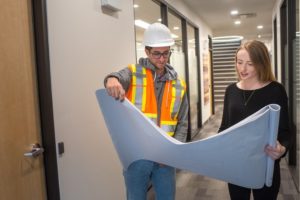What is Curriculum?
In search for the answer to the titled question, I came across a definition to what curriculum is that caused me to pause in reflection. It stated that curriculum is a “floor plan” or blueprint for what is taught, learned, and experienced in the classroom (Su, 2012). Being a carpenter and woodworking & drafting teacher, I was drawn to the statement, but after a time of reflection I realized how incorrect this point of view truly was in my approach to education.

“Youth discussing construction blueprints” by Government of Prince Edward Island is licensed under CC BY-NC-ND 2.0
To me, curriculum is not a plan of what will be taught/learned. Curriculum is more like the building code. Both lay out the minimum requirements needed for what is going to be built/learned. Everyone is mandated to follow the curriculum/building code, but the designer/architect works to create the blueprint and plans. Those plans can be extremely detailed and rigid, or there can be room for customization and changes. Depending on the designer/teacher and how they decide to design their course, students too maybe be a part of this design process, allowing them to customize their learning, focusing on their interests and needs, while still meeting the requirements of the curriculum’s list of learning outcomes.
For example, the BC Woodwork 10 curriculum requires students to learn techniques for stock breakout and woodworking using a variety of tools and equipment, including stationary power equipment (BC’s New Curriculum, n.d.). This is on our list of curricular minimum standard, like what is laid out in the standards of the BC building code. There is more than one way to design an approach to teaching this concept. This is where the teacher would take the time to decide their best approach to teach the concept with the tools, machines, and materials they have in accordance to students’ abilities and pre-knowledge. This is their plan or blueprint for students to follow and learn from. Lesson/unit plans are effectively the blueprint.
The educator, if they are like me, can bring their student into this process and have them personalize it to build on their current knowledge and interests. Students will lay the foundation to future knowledge (much like when building a house) that will eventually become a larger and larger structure. Everyone’s structure will likely look a little different. Some may in fact look very different. In the end, if everything has gone to plan, the student will walk away with that educational structure soundly built for the future, ready to be built upon with more knowledge/ideas.
You describe such a great way for teachers not to get too caught up in following curriculum to the ‘T’. As a building code, this metaphor also allows for the cynicism to live as we saw in the 90s how the new BC building code caused the leaky condo crisis. Well done. I really enjoyed your practical insight.